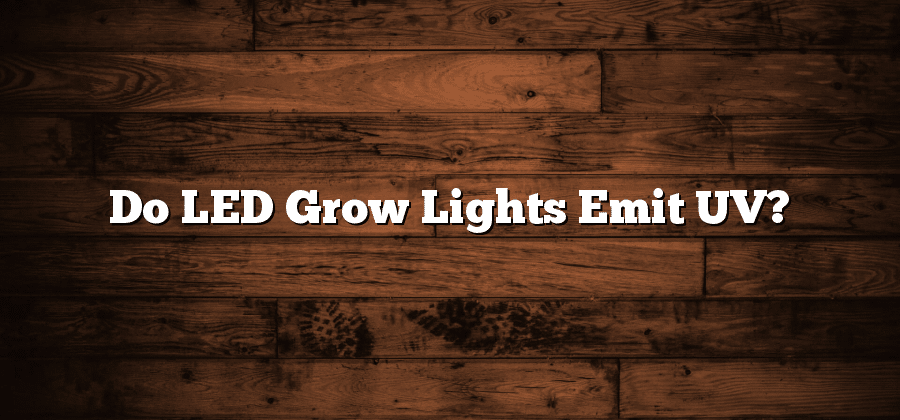Can LED Grow Lights Harm Plants with UV Light?
When it comes to using LED grow lights for cultivating plants, there may be concerns about the potential harm caused by UV light. UV light is known to have both positive and negative effects on plant growth. While some studies suggest that UV light can stimulate certain physiological processes in plants, such as enhanced pigmentation and defense mechanisms, excessive exposure to UV light can be detrimental.
It is important to note that not all LED grow lights emit UV light. In fact, many manufacturers have now developed LED grow lights specifically designed to exclude UV light, as excessive UV exposure can lead to leaf burn and inhibit overall plant development. Therefore, it is crucial for growers to carefully select LED grow lights that have low or no UV emission, ensuring the optimal growing conditions for their plants.
Understanding the Spectrum of LED Grow Lights
The spectrum of LED grow lights plays a crucial role in determining their effectiveness in supporting healthy plant growth. LED lights are designed to emit specific wavelengths, which can be categorized into different color ranges. Each color range has a different impact on plant growth and development.
For example, red and blue wavelengths are the most important for plants as they are essential for photosynthesis. Red light stimulates the flowering and fruiting stages of plants, while blue light promotes vegetative growth. By adjusting the ratio of red to blue light, growers can manipulate the growth and development of their plants. LED grow lights also have the advantage of being highly customizable, allowing growers to tailor the spectrum of light to the specific needs of their crop. So, understanding the spectrum of LED grow lights is key in creating optimal growing conditions for plants.
Determining the UV Output of LED Grow Lights
LED grow lights have become increasingly popular in recent years due to their energy efficiency and customizable spectrum options. However, there is concern among plant enthusiasts about the potential harm that UV light emitted by these lights may have on plant growth. Determining the UV output of LED grow lights is crucial in understanding the impact they may have on plants.
To accurately measure the UV output of LED grow lights, specialized equipment is required. Spectroradiometers, which are sophisticated devices that can measure the intensity of light at different wavelengths, are commonly used for this purpose. By placing the LED grow light at a specific distance from the spectroradiometer, researchers can obtain precise readings of the UV light emitted. This allows for a comprehensive understanding of the UV output and helps in assessing whether it falls within the acceptable range for healthy plant growth.
Additionally, it is important to consider that different LED grow lights may vary in their UV output. Manufacturers typically provide specifications regarding the spectrum output of their lights, including UV measurements. By carefully examining these specifications, growers can choose LED lights that align with the specific needs of their plants. Nonetheless, it is crucial to remember that the impact of UV light on plant growth is highly dependent on factors such as the plant species and its stage of development. Therefore, additional research is necessary to gain a deeper understanding of the effects of UV light from LED grow lights on specific plants.
The Effects of UV Light on Plant Growth
UV light, also known as ultraviolet light, has been linked to both positive and negative effects on plant growth. While the type of UV light and its intensity can impact plants differently, some studies have shown that moderate exposure to UV light can actually stimulate plant growth and enhance their overall health. This is because UV light plays a crucial role in the production of certain compounds, such as flavonoids and anthocyanins, which contribute to a plant’s defense against various environmental stresses.
However, it is important to note that excessive exposure to UV light can have detrimental effects on plants. High levels of UV-B radiation, for instance, can cause damage to the DNA molecules in plant cells, leading to mutations and impaired growth. Additionally, prolonged exposure to UV light can result in the production of reactive oxygen species (ROS), which can cause oxidative stress and harm plant tissues. Therefore, it is essential for growers and horticulturists to carefully consider the UV output of LED grow lights and ensure it is within the optimal range for their specific plants’ needs.
Comparing UV Emission in LED Grow Lights and Traditional Lighting
UV emission is a crucial factor to consider when comparing LED grow lights and traditional lighting for plant growth. While traditional lighting sources, such as incandescent and fluorescent lights, emit a significant amount of UV light, LED grow lights have the advantage of being able to control and limit UV emission. This is achieved through advanced technology that allows manufacturers to tailor the spectrum of the LED lights, ensuring a more precise and targeted wavelength distribution that is optimal for plants.
One of the main benefits of LED grow lights is their ability to provide specific wavelengths of light that promote plant growth without any harmful UV radiation. This is particularly important as excessive UV exposure can adversely affect plants by causing damage to their DNA and inducing photoinhibition. LED grow lights can be designed and adjusted to emit little to no UV light, thus eliminating the risk of plant damage while still providing the necessary energy for photosynthesis. This not only helps to ensure healthy and vigorous growth but also reduces the need for additional protective measures, such as UV-blocking films or coatings, that would be required with traditional lighting sources.






